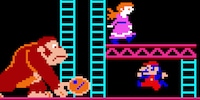
Background information
The history of "Donkey Kong": Highs and lows of Nintendo's favourite gorilla over the last 44 years
by Cassie Mammone

Half a century has passed between the black and white tennis game Pong and the neon-coloured sci-fi blockbuster Cyberpunk 2077. During this time, numerous milestones have significantly shaped game graphics.
Strictly speaking, Pong wasn’t the first video game. That honour goes to Tennis for Two. US physicist William Higinbotham, who helped develop the atomic bomb, converted an oscilloscope into an interactive game in 1958. Pong didn’t appear until 14 years later, but it laid the foundation for a rapidly growing games industry.
In 1972, electronics engineer Allan Alcorn creates the Pong game machine for Atari. Now two people can play digital tennis against each other on a brown and yellow monster in 858 × 525 resolution. Neither software nor code has any influence on how the image is created – neither is there a CPU or RAM. Instead, you need electronics skills to develop the circuits that bring Pong to life. The graphics, if you can even call them that, don’t knock anyone’s socks off. Apart from the two paddles, the ball and the scoreboard, there’s nothing to see. By this time, there are also colour TVs that outperform the black and white cathode ray tube screen in Pong machines. And yet, Pong manages to conquer the world. Simple and ingenious in equal measure, this game marks the start of a rapidly growing industry.
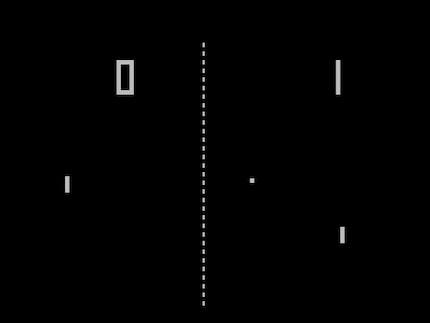
The Pong machine is synonymous with Atari’s initial foundations, but in truth, it was a home console that made the company immortal. In 1977, the company founded by Nolan Bushnell and Ted Dabey launches a black and brown box called the Atari VCS, Video Computer System. The 8-bit console is later renamed the Atari 2600. Games come on cassettes, making it easy to swap them about. Arguably the most famous is amongst them is Space Invaders. The fact that an arcade sensation can suddenly be played at home makes the Atari 2600 the hottest toy on the market. While Space Invaders has mutated into a classic thanks to its addictive gameplay, there are more visually impressive titles in the Atari library.

Alongside Defender (1982) and Battlezone (1983), 1986’s Solaris is one of the most graphically impressive games of its generation. Consoles like the Atari 2600 rely on microchips instead of hard-wired circuits. A processor performance of 1.19 MHz and 128 bytes of RAM sound like nothing. By comparison, a PS5 34 years later will clock 3,000 times faster and boast 125 million times more RAM. However, console performance has long been sufficient for developers to put their visions into action. Doug Neubauer has an idea in mind. He makes a name for himself as a chip designer and creator of classic Star Raiders. Solaris is the title where he finally pushes the Atari 2600 to its limit.
While initial games fit on memory modules (ROM) of just 2 KB, Solaris requires an exorbitant 16 KB. You can use your spaceship to explore 16 different quadrants, all of which look different. At a time when most games consist of one screen, this is nothing short of mind-blowing. You feel like you’re really exploring space when planets whiz past you and spaceships explode into a thousand pixels (roughly 30, actually) as soon as your laser hits them.
After the American games industry collapses in 1983 due to a flood of mediocre games and market oversaturation, Nintendo rises from the ashes. In 1985, the Japanese company launches a games console called the Nintendo Entertainment System, or NES for short, that sweeps away everything that had come before. Batman: Return of the Joker, developed by Japanese studio Sunsoft, stands out in the NES line-up in particular. The game dazzles with detailed backgrounds and a broad colour palette, which creates a wonderfully dark atmosphere despite hardware limitations.

The next big leap in graphics is made possible by the 16-bit Super Nintendo and Sega Mega Drive consoles. These two Japanese companies are in a neck-and-neck race for supremacy in the console market, which translates into a whole host of remarkable games.
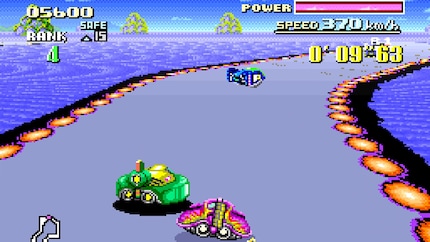
F-Zero is one of the graphic highlights of the Super Nintendo. In 1990, the racing game offers an unprecedented, high-speed car experience. Unlike Super Mario Kart, it also runs in full-screen mode rather than split screen. Thanks to the Mode 7 console feature, Nintendo’s software division led by Shigeru Miyamoto creates deceptively real 3D environments.

The Mega Drive also boasts a comprehensive games library, first and foremost Aladdin. During my week on a retro diet, I already praised the timeless design of this Disney film adaptation. From the animations to the great backgrounds and the sound, everything is just right. It’s all down to Virgin Interactive meticulously scanning hand-drawn designs to reproduce the look of the original film. To make them compatible with Mega Drive hardware, the developers then have to convert the high-resolution images and manually correct the resulting artefacts. All this effort pays off when Aladdin becomes the third best-selling Mega Drive game.
In an era of point-and-click adventures and platformers, one game appears that overshadows all the rest. Doom is fast, dark and bloody. From a first-person perspective, you, a space marine, run through dark corridors full of hellish creatures, turning them into pulp with your shotgun. The whole thing is accompanied by a powerful metal soundtrack.
id Software’s Doom crashes onto the scene as a resounding success in 1993. The studio had already released a 3D shooter a year earlier in the form of Wolfenstein 3D. However, the levels there are exclusively on a horizontal plane, whereas in Doom they’re also vertical. Demons hurl fireballs at you from balconies, and lifts take you to higher or lower areas. There’s a wide variety of enemies, ranging from the possessed Zombieman to the floating, one-eyed Cacodemons and the robot arachnid, Spider Mastermind.
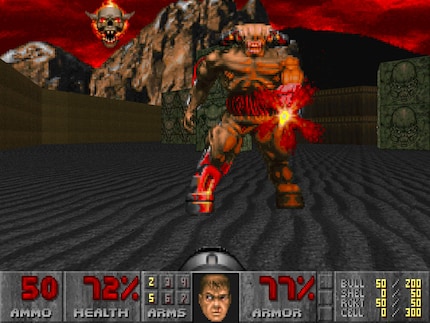
Movement in Doom is smoother and, above all, faster than in any other comparable game. This is down to the engine developed by John Carmack, known simply as the Doom Engine. The team relies on special high-end workstations that run on Steve Jobs’ NeXT operating system. Even when the studio was still working on its platformer series Commander Keen, John Carmack managed to achieve technical wonders time after time. Back then, he had gamers in disbelief with his fluid screen scrolling, something that only the NES was able to master with 2D games such as Super Mario Bros.
The lighting in particular is responsible for the eerie atmosphere in Doom. It calculates the light level of an area using a predefined brightness value, resulting in a colour palette that makes certain sections appear darker and lighter. Even surfaces nearer and further away receive different brightness levels.
Doom marks a turning point in the world of PC games. First-person shooters are now the dominant genre, and id Software cements its reputation as a studio that produces games with outstanding graphics.
The PlayStation as we know it is largely the result of Nintendo snubbing Sony. Originally, the two Japanese developers collaborated on a CD version of the Super Nintendo and so-called Play Station. The latter was also meant to play Nintendo titles. Shortly before release, Nintendo changes its mind and opts for a partnership with the Dutch Philips Group. Sony responds with perhaps the most groundbreaking decision in the company’s history. The Play Station is now called PlayStation and becomes an independent platform.
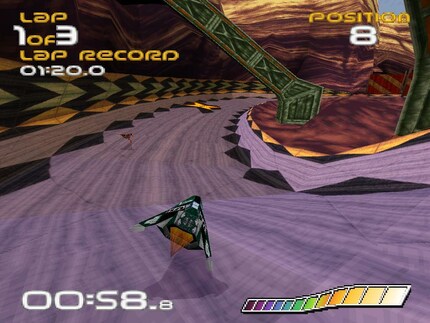
The PlayStation takes the market by storm. A decisive factor is its CD-ROM drive. Until then, the leading console manufacturers Sega and Nintendo relied on modular format. The PlayStation has an excellent command of polygon rendering technology as well as modern 3D geometry and lighting. Furthermore, CDs boast considerably more storage space. This allows you to save complex soundtracks better than ever before thanks to the SPU audio processor. Gone are the days of cheeping chip tunes. This is particularly essential for new game Wipeout from British studio Psygnosis.
In this futuristic racing game, you whizz around the track to tunes such as The Prodigy’s No God. The highlight, however, is Firestarter, also by The Prodigy. You can hear it in the sequel Wipeout 2097 – no track has suited a game better.
In terms of visuals, Wipeout also stands out from the crowd. It starts with those iconic spaceships with auspicious names such as Piranha. The studio was inspired by Matrix Marauders, a title for Amiga and Atari ST.
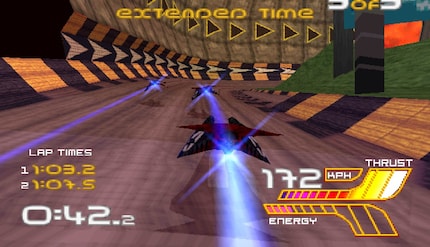
As you look out from the cockpit of the futuristic gliders, this three-dimensional world passes you by at breakneck speed. But it’s not just a case of hurtling about, there are also battles with rockets and mines. In contrast, Super Mario Kart seems sluggish and childlike. Psygnosis was originally aiming for 60 Hz. When it comes down to it, the technical hurdles are insurmountable, and the developer limits itself to 30 Hz. This slows down the playing experience, but even still, the intoxicating speed almost makes you dizzy.
With the help of its 64-bit Nintendo 64 console, Nintendo delivers the next revolution and turns the gaming world on its head in Super Mario 64. Not only is it the first three-dimensional Super Mario game, it’s also the first game to successfully transport a platformer into the third dimension. A supposedly impossible undertaking, given that camera control and depth perception are much more difficult than in 2D.
Mario’s animations also prove a significant challenge. As there’s nothing comparable, the Nintendo team is all on its own, but manages to ace the challenge. The 3D polygon world – pixels are a thing of the past – boasts a boldly colourful and impressive variety never seen before. You can move freely in all directions. Mario can attack enemies from any side, slide down snowy slopes or dive with Dorrie, the sea dragon. Super Mario 64 is a technical marvel as well as a force to be reckoned with, an unforgettable game.
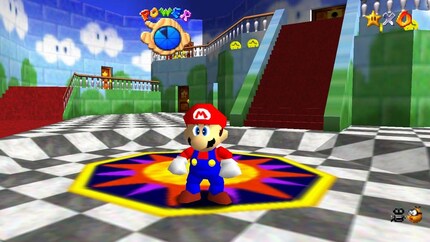
If you think that The Matrix is the template for Max Payne, you’re totally on the wrong track. The Wachowski siblings’ 1998 action sensation is characterised by breathtaking slow-motion effects. In the film noir shooter Max Payne, you also dive smoothly through the air while your opponents practically stand still. According to Sam Lake, the one responsible for the story and who would later become game director of Finnish studio Remedy, the parallels are merely a lucky coincidence. The iconic slow-motion move called bullet time was already part of the game when The Matrix kicked off the hype for Hong Kong action cinema. Remedy drew inspiration from that, just like the Wachowskis.
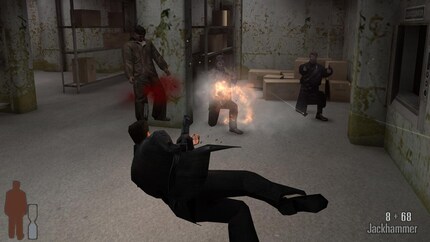
In 2001, the bullet-time effects in Max Payne are something the game world has never seen before. The way the camera follows bullets as they slowly but fatally head towards their target is simply groundbreaking.
The dark story is told in an unusual way with comic panels set to music that reinforce the film noir style. And just like the unique gameplay, Max Payne’s face is forever etched in our collective memory. As the studio has no budget for a professional actor, Sam Lake unceremoniously lends his face to the hero. Technology doesn’t allow for animations, so Max’s face just consists of three interchangeable expressions: neutral, grinning and his shooting face, which looks a bit like he’s constipated.
Missing its widely announced release date of 30 September 2003 couldn’t halt the success of Half-Life 2. And having its source code stolen by a German hacker wasn’t detrimental either. Gordon Freeman’s fight against the sinister Combine aliens has that wow factor with its gripping action, intelligent enemy design, and Source, an engine with a long and storied history.
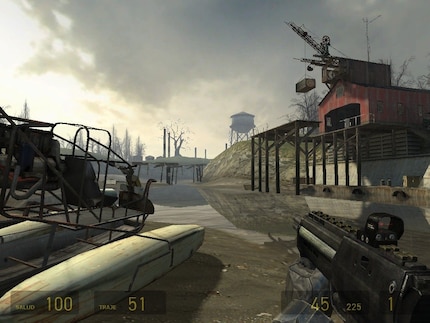
Half-Life 2 is based on the Source engine, a progression from the GoldSRC engine, which in turn is a heavily modified version of the Quake engine. This antiquarian-looking base doesn’t hinder the game in any way – quite the opposite. It enables you to use more than 3,500 models and almost 10,000 materials compared with 300 models and 4,000 materials in the first Half-Life. This allows Valve’s designers to create iconic levels, such as the Orwellian City 17, the war-torn suburbs and the Nova Prospekt prison characterised by thick corrugated glass walls. You can even detect the outlines of patrolling Combine soldiers behind them.
The detailed facial animations that lend the characters more expressiveness are at least just as impressive as the game’s level design. Without these animations, Alyx would never become one of the most popular side characters. The water design, which is particularly effective in the racing boat passages, looks highly realistic thanks to ambient reflections and movements. Most of these are just illusions that have nothing to do with modern real-time lighting, such as ray tracing. Nevertheless, humans, monsters and robot dogs have never looked more convincing.
Speaking of realism, physics plays an even more important role than in the first part. You use gravity guns to catapult barrels at your opponents and repurpose saw blades into deadly projectiles. Physics are harnessed just as often in puzzles. For example, you lift a ramp from the water so that Gordon can overcome an obstacle with his boat. At a time when most objects in games are static, this is a game changer.
The hardware-hungry nature of Crytek’s first-person shooter is so legendary that it’s become a meme. Crysis offers the kind of graphic splendour you only get on a new console. You’re a super soldier with a special suit that makes you invisible or lets you jump onto houses, and you land on a tropical island. Here, you investigate strange occurrences that turn out to be an alien invasion.
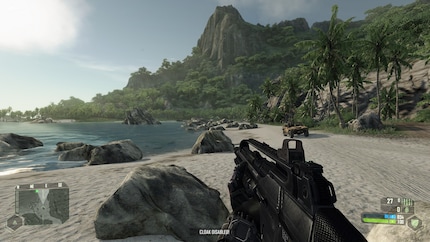
Crysis plays like a gripping action film with graphics in the leading role. It starts with your comrades, whose faces are the very first thing you see – right up close. My goodness, they look fantastic. This is all thanks to the clever use of shaders and a heat map for the face, which determines where light falls. Even pores and dainty dimples are visible. Crysis is years ahead of the competition.

The game continues to amaze me even after jumping out of the plane. You fly through fluffy clouds then land in the sea, which reflects the moonlight. When exploring the dense jungle, you have to be careful not to stumble into the enemy while marvelling at plastic palm leaves and tall grass.
CryEngine delivers high-resolution textures that can even display details on the ground, such as vehicle tracks. There are varied stony floors, not simply two-dimensional textures. And of course, you’re treated to spectacular explosions when barrels fly into the air or you go into battle with the tank.
Here’s one reason PCs are still struggling with Crysis years later. Crytek speculated during development that the CPU clock would continue to make huge leaps. But 8 GHz Pentiums remain wishful thinking. Instead, the trend is towards more cores and more threads. But these are of little use to the underlying CryEngine, which is why the «But can it run Crysis?» meme will be doing the rounds long after its expiry date.
Consoles also know how to show off, and nobody does it better in 2009 than Uncharted 2. Knee-high snow that leaves detailed tracks, caves illuminated by magical blue torchlight and picturesque mountain villages against the backdrop of the Himalayas.
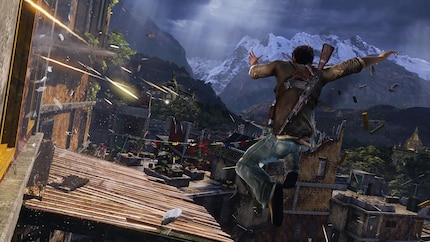
Even the first few minutes of Uncharted 2 are both sweat-inducing and breathtaking. You control hero of the story, Nathan Drake, as he climbs out of a derailed train dangling over a precipice. With spectacular manoeuvres, you pull your way along the train, inside and outside the carriage. Handrails break off, benches fall into the abyss and the whole train slowly starts to slide down the cliff. All while you panic, trying to find a way up. More than 60 camera angles are used to make the scene as dramatic as possible.
The train scene is just the prelude to a visually fantastic journey around the globe, with splendour and richness of detail you’ve never experienced before.
When you think of The Witcher 3, you think of open world. Years later, the The Witcher’s homeland will still be the genre reference. A vivid fantasy world stretches as far as the eye can see, with unimagined game freedoms, from the densely populated town of Novigrad to the military camps of the Kingdom of Nilfgaard and the snow-covered peaks of Skellige. The reveal trailer shows Geralt hunting a griffin. Fans are blown away by the strength of the visuals when they first lay eyes on it. Even though some fans complained that the final game doesn’t look exactly like the trailer, the consensus is that The Witcher 3 is one of the most beautiful games ever.

Polish studio CD Projekt RED uses its proprietary REDengine 3. The developers have created a massive world that you can explore with practically no loading times. One reason for its magical appeal is that it’s based on real landscapes. CD Projekt RED headed to Scotland for the rugged island of Skellige, for instance. Various rock formations and fjords are direct replicas of the country’s natural heritage.
Another reason the world looks so authentic is the fidelity to the real world when it comes to topography, ensuring it would make sense. Rivers are generally located where they would’ve found their way in nature. Villages and houses are located in places that would’ve been customary at the time, not simply placed according to visual criteria. This includes interior design, which in the case of Skellige was inspired by Vikings. In their time, the fireplace was usually at the centre of a home.
The engine also enables a dynamic camera system that zooms out to show epic battles in all their glory or makes dialogue more personal with close-ups.
Speaking of dialogue, facial and body animations as well as hair design alone takes up almost 30% of performance. But this is what removes any competition from other open-world games. The actors, the force behind this, can really get stuck in, and not just in acrobatic love scenes on stuffed unicorns.
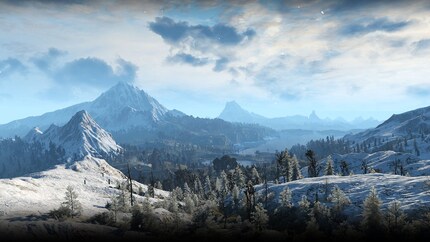
In the same year that Naughty Dog proves once again with The Last of Us Part 2 that hardly anything is a patch on its offerings when it comes to level of detail and facial animations, CD Projekt RED doubles down with a new masterpiece. It finally earns this title with the 2.0 update and Phantom Liberty expansion. The verticality, immense density of environmental details and physical light simulation through ray tracing are impressive right from the start. Just as long as none of the countless bugs spoil your experience.

As well as gameplay improvements, the 2.0 update includes numerous visual changes, making a high-end PC a prerequisite for this graphic splendour. This allows you to enjoy things like path tracing, which changes the entire lighting design and makes the neon-coloured Night City metropolis look even more impressive. The city’s Blade Runner setting provides the perfect playground for designers to let off steam with their craft. It’s showcased best in Dogtown, an expansion of the new city district. Every street corner is dominated by a strange building with gaudy LED lighting that’s reflected in puddles and windows.
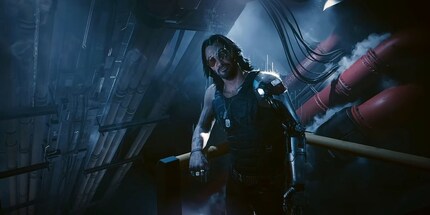
The dialogue-heavy game is also a hit when it comes to facial animations. Various techniques work together in perfect symbiosis. Subsurface scattering simulates light on semi-transparent surfaces, such as beards. Realistic skin lighting and facial expressions ensure that emotions can be clearly distinguished. And detailed clothing tops it all off.
Just like in The Witcher 3, the camera is dynamic in conversations and lends additional expression to the characters’ emotions. The richness of detail in the world is hard to beat, from the dusty Badlands with rusty solar fields, to flashy Japantown and the restricted area of Dogtown. This futuristic open-world spectacle is the current benchmark for how good games can look.
As a child, I wasn't allowed to have any consoles. It was only with the arrival of the family's 486 PC that the magical world of gaming opened up to me. Today, I'm overcompensating accordingly. Only a lack of time and money prevents me from trying out every game there is and decorating my shelf with rare retro consoles.
Interesting facts about products, behind-the-scenes looks at manufacturers and deep-dives on interesting people.
Show all
Background information
by Cassie Mammone

Background information
by Kim Muntinga

Background information
by Philipp Rüegg